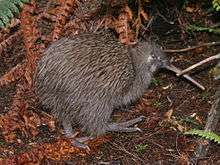New Zealand fernbird
The New Zealand fernbird or simply fernbird (Poodytes punctatus) is an insectivorous bird endemic to New Zealand. In the Māori language, it is named kōtātā or mātātā.
| New Zealand fernbird | |
|---|---|
 | |
| Scientific classification | |
| Kingdom: | Animalia |
| Phylum: | Chordata |
| Class: | Aves |
| Order: | Passeriformes |
| Family: | Locustellidae |
| Genus: | Poodytes |
| Species: | P. punctatus |
| Binomial name | |
| Poodytes punctatus | |
| Synonyms | |
|
Bowdleria punctata | |
Taxonomy
The New Zealand fernbird was described by the French zoologists Jean Quoy and Joseph Gaimard in 1832 from a specimen collected in Tasman Bay, South Island, New Zealand. They coined the binomial name, Synallaxis punctata.[2][lower-alpha 1]
There are five subspecies:
- B. p. punctata (South Island fernbird)
- B. p. vealeae (North Island fernbird)
- B. p. stewartiana (Stewart Island fernbird)
- B. p. wilsoni (Codfish Island fernbird)
- B. p. caudata (Snares fernbird)
The related Chatham fernbird (Poodytes rufescens), which, became extinct around 1900, was sometimes treated as a subspecies of this species.[4]
Description
The New Zealand fernbird is a rich brown above and white below, with brown spots on both the throat and breast. Early settlers called it the "swamp sparrow" no doubt because of its colouration.[5] The tail feathers are thin, dark brown, and spine-like. The birds reach a length of 18 cm (7 in) – as measured from tip of beak to end of tail. However, almost half of that is tail.[5]
Ecology
_(cropped).jpg)
The New Zealand fernbird is a ground-dwelling bird, and is a reluctant flier, travelling mainly on foot or in occasional short flights of less than 15 metres. In the 19th century, Buller described it as "one of our most common"[5] (birds) but it has been adversely affected by the subsequent widespread destruction of its natural wetland habitat following European settlement and is now rare.[5]
The birds nest in sedges or other vegetation close to the ground, making a deep woven cup of dried rushes lined with feathers. Breeding occurs from September to February, producing clutches of 2-3 pinkish-white eggs with brown or purple speckles. The Māori phrase "te whare o te mātātā" (a fernbird’s house) describes a woven flax cape, made to keep out the weather;[6] a testament to the design and strength of the nest.
Place in Māori culture
Māori revered the fernbird as an "oracle" or "wise bird" (Manu tohu).[5] The calls of the bird were interpreted as heralding success or failure in daily activities such as fishing but on a more serious level could also portend prosperity and health or disaster and death.[5]
Notes
- Although the volume of the Voyage de la corvette l'Astrolabe has 1830 on the title page it was not published until 1832.[3]
References
- BirdLife International (2012). "Bowdleria punctata". IUCN Red List of Threatened Species. 2012. Retrieved 26 November 2013.CS1 maint: ref=harv (link)
- Quoy, Jean; Gaimard, Joseph Paul (1830). Dumont d'Urville, Jules (ed.). Voyage de la corvette l'Astrolabe : exécuté par ordre du roi, pendant les années 1826-1827-1828-1829: Zoologie (in French). Volume 1. Paris: J. Tastu. p. 255.
- Mlíkovský, Jiří (2012). "The dating of the ornithological part of Quoy and Gaimard's "Voyage de l'Astrolabe"". Zoological bibliography. 2 (2&3): 59–69.
- BirdLife International (2012). "Bowdleria rufescens". IUCN Red List of Threatened Species. 2012. Retrieved 26 November 2013.CS1 maint: ref=harv (link)
- "Wetlands of New Zealand; A Bitter-Sweet story", Janet Hunt, Random House, 2007
- Christina, Troup (24 September 2007). "Wetland birds - Kingfishers and fernbirds – wetland margins". Te ara Encyclopedia. Retrieved 26 March 2020.
- Falla, R.A., Sibson, R.B., and Turbott, E.G. (1970). A Field Guide to the Birds of New Zealand. London: Collins. ISBN 0-00-212022-4
- Marshall, J., Kinsky, F.C., and Robinson, C.J.R. (1982). The Fiat Book of Common birds in New Zealand. Wellington: A.H. and A.W. Reed. ISBN 0-589-00759-9

